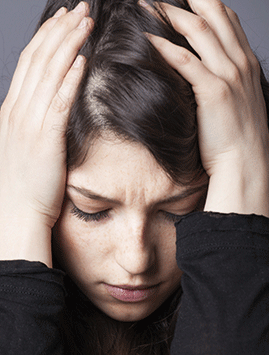Bring me sunshine

Natural ways to beat the symptoms of Seasonal Affective Disorder
As winter draws in and the daylight hours grow shorter, many of us tend to feel more lethargic and the prospect of comfort food becomes more appealing. An estimated 20 per cent of the UK population are thought to suffer from a form of winter depression known as Seasonal Affective Disorder, with two per cent experiencing symptoms that become utterly debilitating.
According to the Seasonal Affective Disorder Association, or SADA, (www.sada.org.uk) the symptoms of SAD recur regularly each winter and usually start between September and November, continuing until March or April. Symptoms range from depression, lethargy, poor cognitive function and anxiety to sleep problems, loss of libido, social problems and lowered immunity.
The exact cause of SAD isn’t clearly understood, but it is generally thought to be linked to reduced exposure to sunlight during the winter time. It is believed that a lack of sunlight may affect the working of the part of the brain known as the hypothalamus, which in turn affects the body’s production of the hormones melatonin and serotonin. Melatonin is responsible for making us feel sleepy, and it has been found that people with SAD produce much higher levels of melatonin during the winter than other people. Serotonin is known as the feelgood hormone because it affects our mood, appetite and sleep. A lack of sunlight may lead to lower serotonin levels, which is linked to depression. So what can be done to help these symptoms?
Good nutrition
“Dietary choices that fail to provide the full spectrum of vitamins and minerals necessary for health may contribute to poor brain function and low mood,” says Aimee Benbow, technical manager with Viridian Nutrition (www.viridian-nutrition.com). “We know that our brains are around 70 per cent fat and the traditional belief that fat makes us fat has driven many individuals to pursue a low fat diet. Supplying the body with a range of good fats from fish and plant sources (monounsaturated, polyunsaturated and some saturated fats) promotes cellular health, which may improve mood. A diet low in omega-3 essential fatty acids is stressful to the body and mind. Higher intakes are linked to improved mood and better adaptation to stress.”
“High sugar foods can promote a cycle of elevated blood glucose followed by very low blood glucose levels,” adds Jenny Hall, technical services assistant with Viridian Nutrition. “This can contribute to brain fog, lethargy and low mood – often the signs associated with Seasonal Affective Disorder. Mood foods, once the craving for sugar subsides (often reported as soon as two to three days into a sugar detox) taste great, are satiating and nourish our brains and bodies. Supermood foods include raw organic coconut oil, sustainably-sourced fish, grass-fed meats, grass-fed animal products, avocado, nuts and seeds partnered up with a nutrient-dense variety of fermented, raw or lightly-steamed vegetables and a couple of fruits each day. Poor magnesium status has been linked to low mood, anxiety and depression, therefore consuming foods rich in magnesium such as dark green leafy vegetables, dark chocolate and dried fruit is recommended.”

Light therapy
“This can be a very effective drug-free option for SAD,” says Enid, Taylor, a naturopathic doctor and co-founder of the Taymount Clinic (www.taymount.com). “It simply involves daily exposure to bright light, usually from a light box, which can help compensate for the lack of exposure to sunlight in winter. It helps correct the body’s circadian rhythms and rebalances hormones, such as melatonin and serotonin, disruption of which may be responsible for many of the symptoms of SAD.”
Regular exercise
“The endorphins released through exercise can increase the feeling of wellbeing, and has been proven to ease the symptoms of depression and anxiety in some cases,” says Sid Betty, a personal trainer and group exercise instructor (www.livewellbhappy.co.uk). “NHS Direct prescribes 150 minutes per week of moderate/vigorous exercise for general wellbeing (roughly 20 minutes per day). There are so many routines you can do with just your body weight so ditch the gym and head for your local park – the fresh air and daylight will do you good. Be sure to put on some base layers and waterproofs if it’s wet and some fluorescent bands or a high vis bib if it’s dark out. Start off by preparing the body with a brisk walk or jog to get your pulse rate up and loosen up with some dynamic stretches. Pick two to four bodyweight exercises such as squats, lunges, press-ups or mountain climbers. Perform the first one for 20 seconds, trying to complete as many as possible, before resting for 10 seconds, then moving on to the next exercise. Follow this format for eight minutes. Rest for two minutes and repeat two to four times, trying to beat or match the reps achieved in the previous round (but don’t sacrifice good form for more reps).”
Meditation
“Vedic meditation helps reduce stress by calming down the activity of the part of the brain known as the amygdala, which is the seat of our fight or flight response,” explains Will Williams, a meditation expert (www.willwilliamsmeditation.co.uk). “This tends to result in a 25 to 33 per cent reduction in the amount of the stress hormone, cortisol, we have in our system. As a result, we become much more resilient to stress, and with it SAD. There is also a corresponding balancing of much of our hormone production, including the key neurochemicals melatonin and serotonin, helping to lift our mood. In addition, Vedic meditation regulates our daily biological (circadian) rhythms, helping us tune into the rhythms of the sun and the seasons. And importantly, for those who feel sluggish, it gives you such deep hits of rest (on average 33 per cent deeper than deep sleep), you feel much more rested and revitalised. This is amplified by the improved sleep quality we experience when we practise. It also greatly enhances concentration, as we found to our delight when researchers tested our students versus those of other performance-enhancing and meditation techniques and found that the people we had taught significantly outperformed every other test group. Indeed, the researcher who discovered SAD and came up with the concept of light therapy, Norman Rosenthal, is an avid meditator and considers it to be an invaluable tool for offsetting stress, depression and SAD.”
Supplements for SAD
“There are a number of natural supplements which may help SAD,” says Enid Taylor. “But remember some of these may interact with prescription drugs, so consult your doctor before taking them. Here are some suggestions:
Vitamin D
Sunlight is required by the body to make vitamin D and when the body’s stores become depleted in winter, supplementing with vitamin D throughout the dark months can help prevent deficiency and may improve one’s mood.
Tryptophan or 5-HTP
Reduced light exposure can result in a drop in levels of the ‘feelgood’ hormone, serotonin, which is thought to play a role in the depressive symptoms of SAD. Tryptophan and 5-HTP are turned into serotonin in the body, so supplements will boost the body’s serotonin levels, helping to combat depression.
St John’s Wort
Several studies have shown that St John’s Wort can be as effective as anti-depressants as a treatment for depression, so it’s well worth trying.
Try this!
“Aromatherapy is a good thing to turn to during the long dark days of winter,” says Tim Harris of G Baldwin & Co, independent health store (www.baldwins.co.uk). “Summery citrus oils, grounding clary sage or frankincense are all good to diffuse. Patchouli and lime also make a good combination.”
Read more Your Health articles here...